Change Management Project: Strategic, Tactical, and Operational Levels
VerifiedAdded on 2023/01/04
|7
|1049
|56
Project
AI Summary
This project provides a comprehensive analysis of change management within an organizational context, specifically focusing on an e-learning venture. It begins with a definition of change, emphasizing its importance in adapting to modern business environments. The project then delves into how change is handled at strategic, tactical, and operational levels. At the strategic level, it highlights the significance of top management support, stakeholder involvement, and cultural shifts. The tactical level focuses on project management and training, while the operational level addresses day-to-day processes like content management. The conclusion emphasizes the importance of change for organizational success and growth, summarizing the different approaches at each level and offering personal opinions on the subject. The project references several academic sources to support its claims.
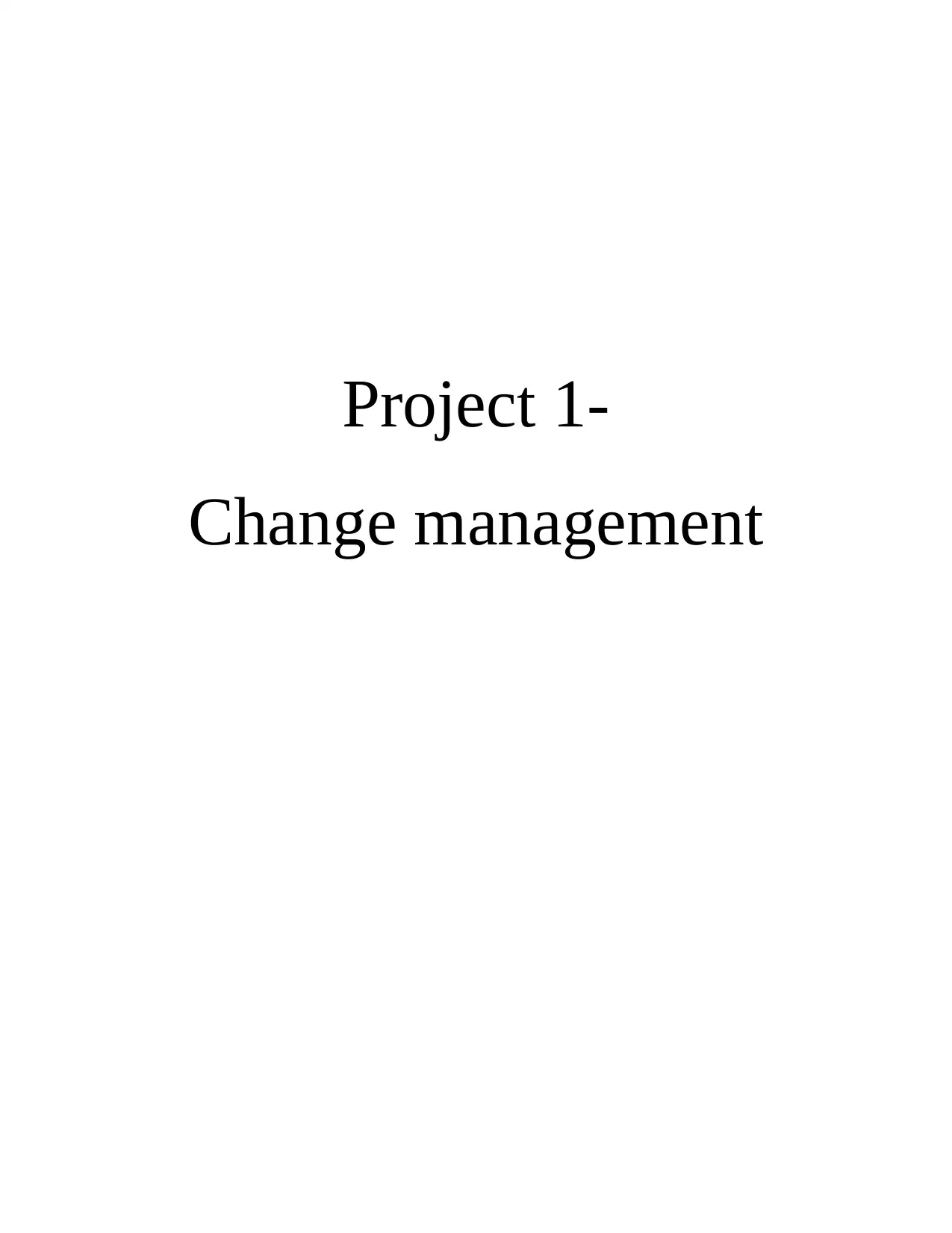
Project 1-
Change management
Change management
Paraphrase This Document
Need a fresh take? Get an instant paraphrase of this document with our AI Paraphraser
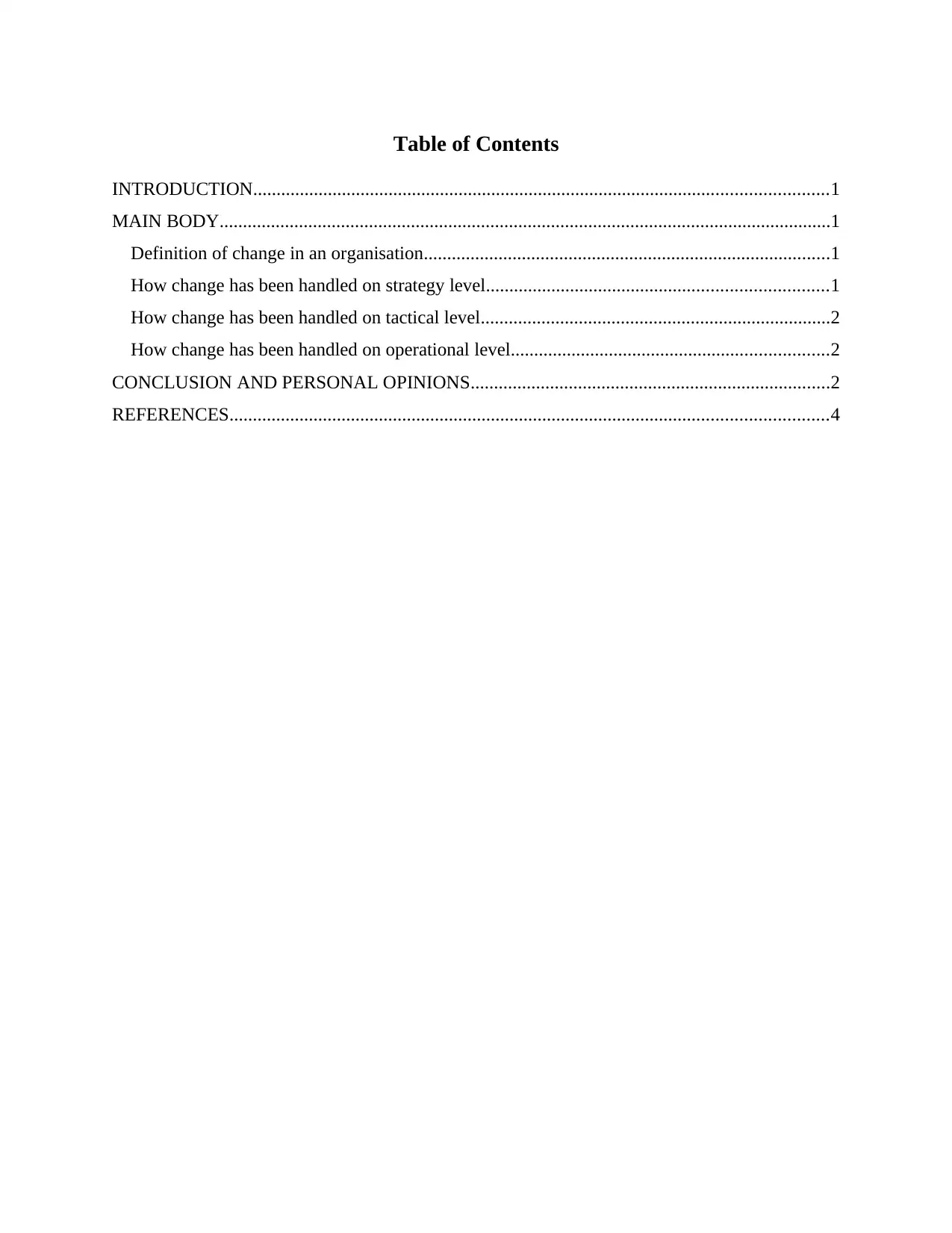
Table of Contents
INTRODUCTION...........................................................................................................................1
MAIN BODY...................................................................................................................................1
Definition of change in an organisation.......................................................................................1
How change has been handled on strategy level.........................................................................1
How change has been handled on tactical level...........................................................................2
How change has been handled on operational level....................................................................2
CONCLUSION AND PERSONAL OPINIONS.............................................................................2
REFERENCES................................................................................................................................4
INTRODUCTION...........................................................................................................................1
MAIN BODY...................................................................................................................................1
Definition of change in an organisation.......................................................................................1
How change has been handled on strategy level.........................................................................1
How change has been handled on tactical level...........................................................................2
How change has been handled on operational level....................................................................2
CONCLUSION AND PERSONAL OPINIONS.............................................................................2
REFERENCES................................................................................................................................4

⊘ This is a preview!⊘
Do you want full access?
Subscribe today to unlock all pages.

Trusted by 1+ million students worldwide
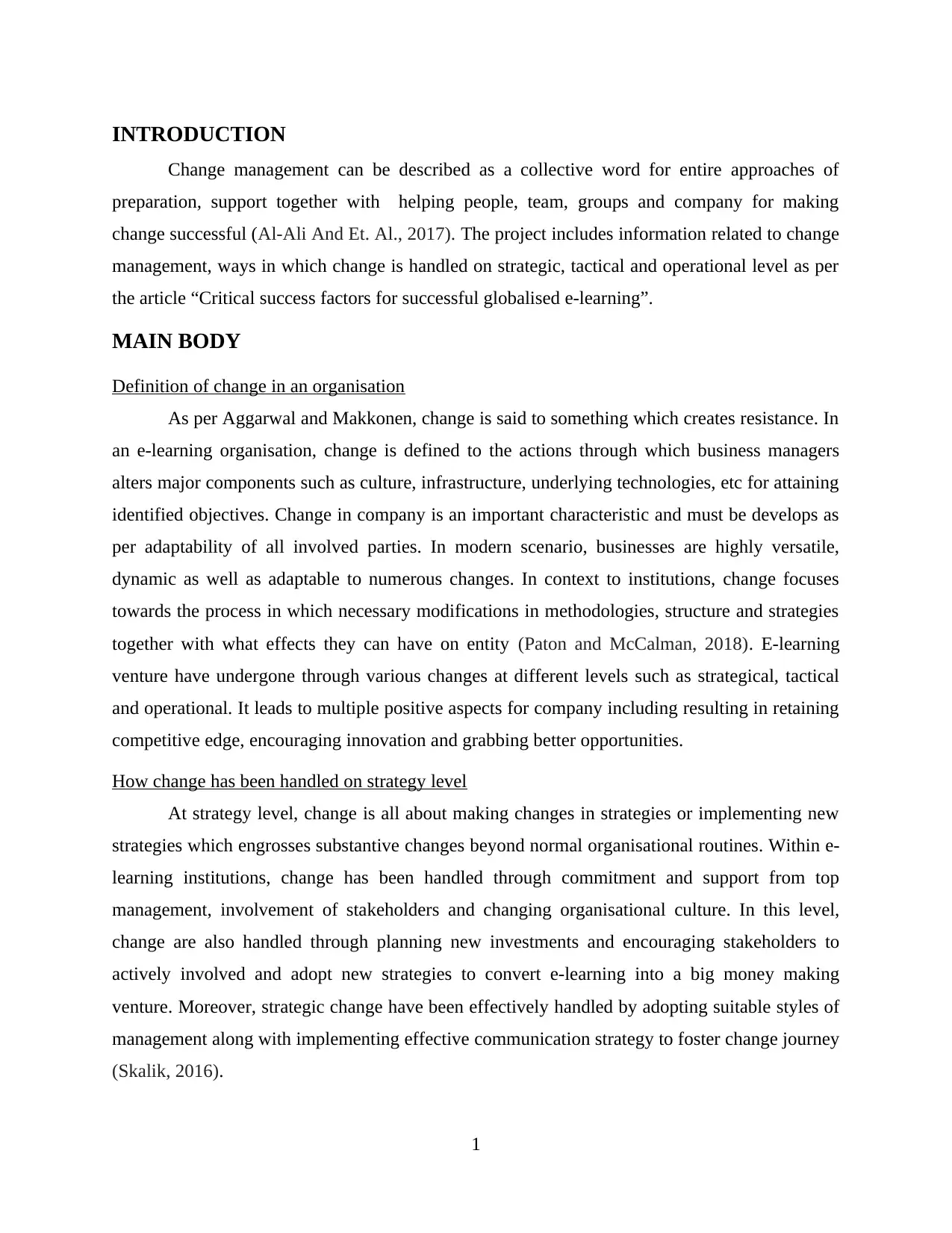
INTRODUCTION
Change management can be described as a collective word for entire approaches of
preparation, support together with helping people, team, groups and company for making
change successful (Al-Ali And Et. Al., 2017). The project includes information related to change
management, ways in which change is handled on strategic, tactical and operational level as per
the article “Critical success factors for successful globalised e-learning”.
MAIN BODY
Definition of change in an organisation
As per Aggarwal and Makkonen, change is said to something which creates resistance. In
an e-learning organisation, change is defined to the actions through which business managers
alters major components such as culture, infrastructure, underlying technologies, etc for attaining
identified objectives. Change in company is an important characteristic and must be develops as
per adaptability of all involved parties. In modern scenario, businesses are highly versatile,
dynamic as well as adaptable to numerous changes. In context to institutions, change focuses
towards the process in which necessary modifications in methodologies, structure and strategies
together with what effects they can have on entity (Paton and McCalman, 2018). E-learning
venture have undergone through various changes at different levels such as strategical, tactical
and operational. It leads to multiple positive aspects for company including resulting in retaining
competitive edge, encouraging innovation and grabbing better opportunities.
How change has been handled on strategy level
At strategy level, change is all about making changes in strategies or implementing new
strategies which engrosses substantive changes beyond normal organisational routines. Within e-
learning institutions, change has been handled through commitment and support from top
management, involvement of stakeholders and changing organisational culture. In this level,
change are also handled through planning new investments and encouraging stakeholders to
actively involved and adopt new strategies to convert e-learning into a big money making
venture. Moreover, strategic change have been effectively handled by adopting suitable styles of
management along with implementing effective communication strategy to foster change journey
(Skalik, 2016).
1
Change management can be described as a collective word for entire approaches of
preparation, support together with helping people, team, groups and company for making
change successful (Al-Ali And Et. Al., 2017). The project includes information related to change
management, ways in which change is handled on strategic, tactical and operational level as per
the article “Critical success factors for successful globalised e-learning”.
MAIN BODY
Definition of change in an organisation
As per Aggarwal and Makkonen, change is said to something which creates resistance. In
an e-learning organisation, change is defined to the actions through which business managers
alters major components such as culture, infrastructure, underlying technologies, etc for attaining
identified objectives. Change in company is an important characteristic and must be develops as
per adaptability of all involved parties. In modern scenario, businesses are highly versatile,
dynamic as well as adaptable to numerous changes. In context to institutions, change focuses
towards the process in which necessary modifications in methodologies, structure and strategies
together with what effects they can have on entity (Paton and McCalman, 2018). E-learning
venture have undergone through various changes at different levels such as strategical, tactical
and operational. It leads to multiple positive aspects for company including resulting in retaining
competitive edge, encouraging innovation and grabbing better opportunities.
How change has been handled on strategy level
At strategy level, change is all about making changes in strategies or implementing new
strategies which engrosses substantive changes beyond normal organisational routines. Within e-
learning institutions, change has been handled through commitment and support from top
management, involvement of stakeholders and changing organisational culture. In this level,
change are also handled through planning new investments and encouraging stakeholders to
actively involved and adopt new strategies to convert e-learning into a big money making
venture. Moreover, strategic change have been effectively handled by adopting suitable styles of
management along with implementing effective communication strategy to foster change journey
(Skalik, 2016).
1
Paraphrase This Document
Need a fresh take? Get an instant paraphrase of this document with our AI Paraphraser
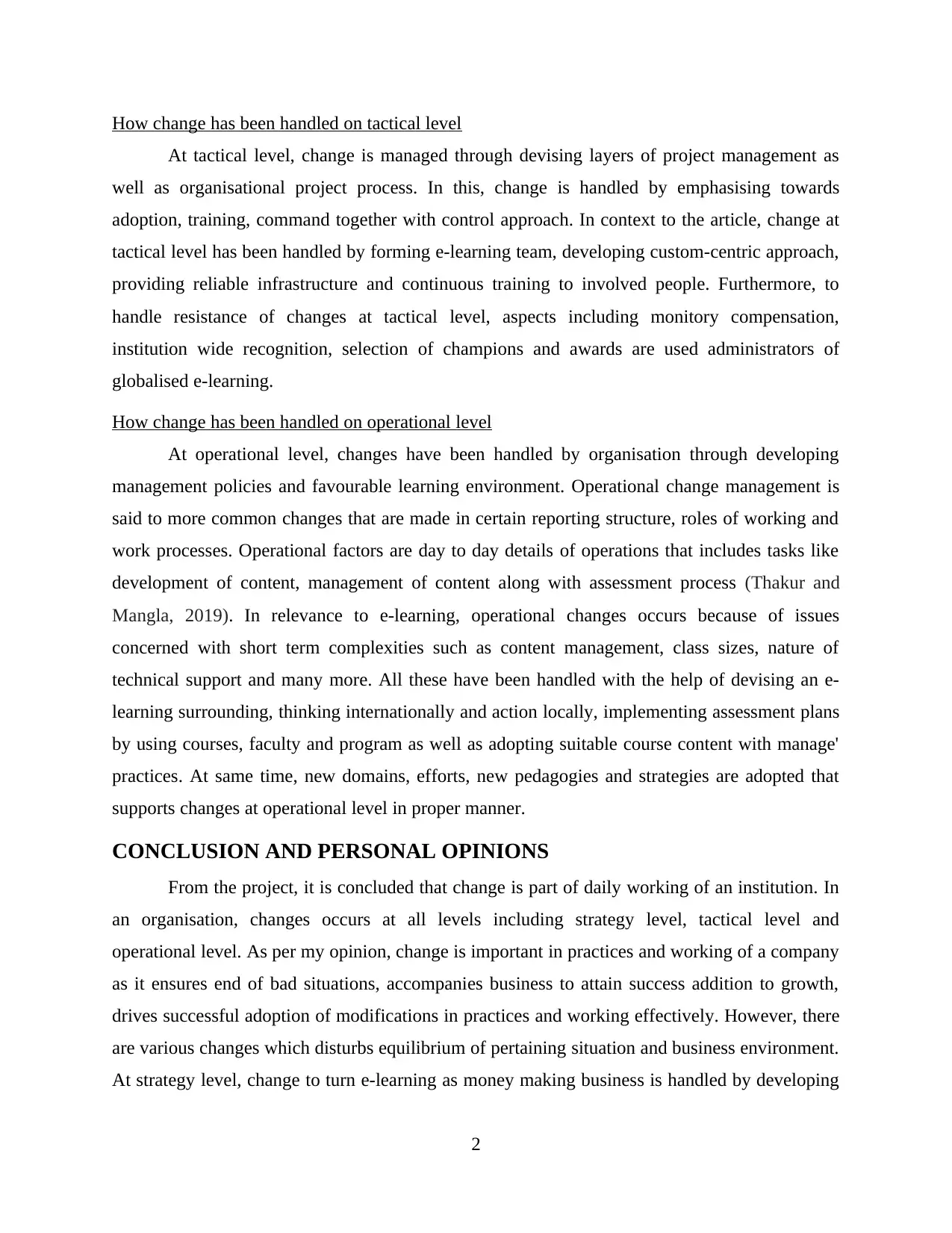
How change has been handled on tactical level
At tactical level, change is managed through devising layers of project management as
well as organisational project process. In this, change is handled by emphasising towards
adoption, training, command together with control approach. In context to the article, change at
tactical level has been handled by forming e-learning team, developing custom-centric approach,
providing reliable infrastructure and continuous training to involved people. Furthermore, to
handle resistance of changes at tactical level, aspects including monitory compensation,
institution wide recognition, selection of champions and awards are used administrators of
globalised e-learning.
How change has been handled on operational level
At operational level, changes have been handled by organisation through developing
management policies and favourable learning environment. Operational change management is
said to more common changes that are made in certain reporting structure, roles of working and
work processes. Operational factors are day to day details of operations that includes tasks like
development of content, management of content along with assessment process (Thakur and
Mangla, 2019). In relevance to e-learning, operational changes occurs because of issues
concerned with short term complexities such as content management, class sizes, nature of
technical support and many more. All these have been handled with the help of devising an e-
learning surrounding, thinking internationally and action locally, implementing assessment plans
by using courses, faculty and program as well as adopting suitable course content with manage'
practices. At same time, new domains, efforts, new pedagogies and strategies are adopted that
supports changes at operational level in proper manner.
CONCLUSION AND PERSONAL OPINIONS
From the project, it is concluded that change is part of daily working of an institution. In
an organisation, changes occurs at all levels including strategy level, tactical level and
operational level. As per my opinion, change is important in practices and working of a company
as it ensures end of bad situations, accompanies business to attain success addition to growth,
drives successful adoption of modifications in practices and working effectively. However, there
are various changes which disturbs equilibrium of pertaining situation and business environment.
At strategy level, change to turn e-learning as money making business is handled by developing
2
At tactical level, change is managed through devising layers of project management as
well as organisational project process. In this, change is handled by emphasising towards
adoption, training, command together with control approach. In context to the article, change at
tactical level has been handled by forming e-learning team, developing custom-centric approach,
providing reliable infrastructure and continuous training to involved people. Furthermore, to
handle resistance of changes at tactical level, aspects including monitory compensation,
institution wide recognition, selection of champions and awards are used administrators of
globalised e-learning.
How change has been handled on operational level
At operational level, changes have been handled by organisation through developing
management policies and favourable learning environment. Operational change management is
said to more common changes that are made in certain reporting structure, roles of working and
work processes. Operational factors are day to day details of operations that includes tasks like
development of content, management of content along with assessment process (Thakur and
Mangla, 2019). In relevance to e-learning, operational changes occurs because of issues
concerned with short term complexities such as content management, class sizes, nature of
technical support and many more. All these have been handled with the help of devising an e-
learning surrounding, thinking internationally and action locally, implementing assessment plans
by using courses, faculty and program as well as adopting suitable course content with manage'
practices. At same time, new domains, efforts, new pedagogies and strategies are adopted that
supports changes at operational level in proper manner.
CONCLUSION AND PERSONAL OPINIONS
From the project, it is concluded that change is part of daily working of an institution. In
an organisation, changes occurs at all levels including strategy level, tactical level and
operational level. As per my opinion, change is important in practices and working of a company
as it ensures end of bad situations, accompanies business to attain success addition to growth,
drives successful adoption of modifications in practices and working effectively. However, there
are various changes which disturbs equilibrium of pertaining situation and business environment.
At strategy level, change to turn e-learning as money making business is handled by developing
2
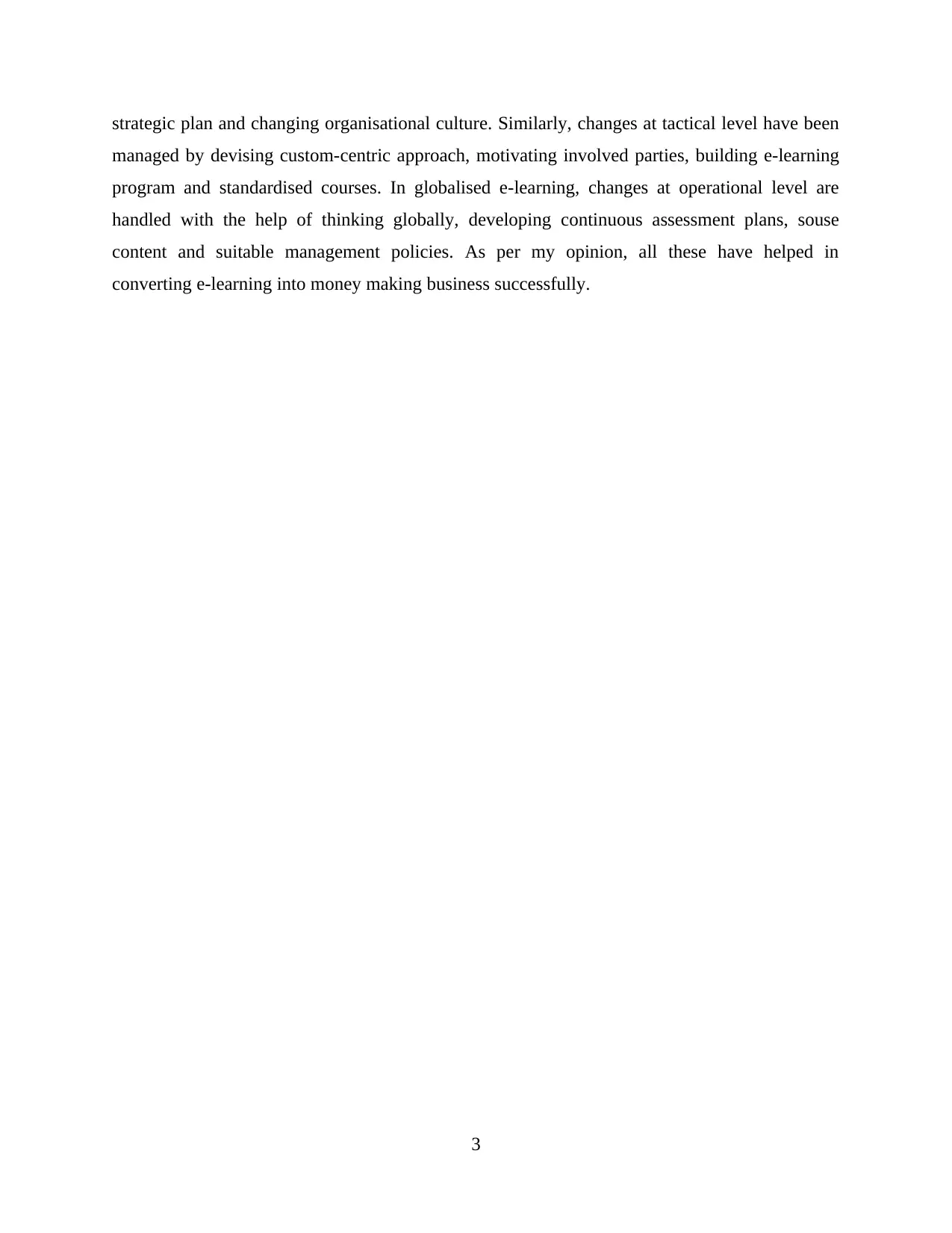
strategic plan and changing organisational culture. Similarly, changes at tactical level have been
managed by devising custom-centric approach, motivating involved parties, building e-learning
program and standardised courses. In globalised e-learning, changes at operational level are
handled with the help of thinking globally, developing continuous assessment plans, souse
content and suitable management policies. As per my opinion, all these have helped in
converting e-learning into money making business successfully.
3
managed by devising custom-centric approach, motivating involved parties, building e-learning
program and standardised courses. In globalised e-learning, changes at operational level are
handled with the help of thinking globally, developing continuous assessment plans, souse
content and suitable management policies. As per my opinion, all these have helped in
converting e-learning into money making business successfully.
3
⊘ This is a preview!⊘
Do you want full access?
Subscribe today to unlock all pages.

Trusted by 1+ million students worldwide
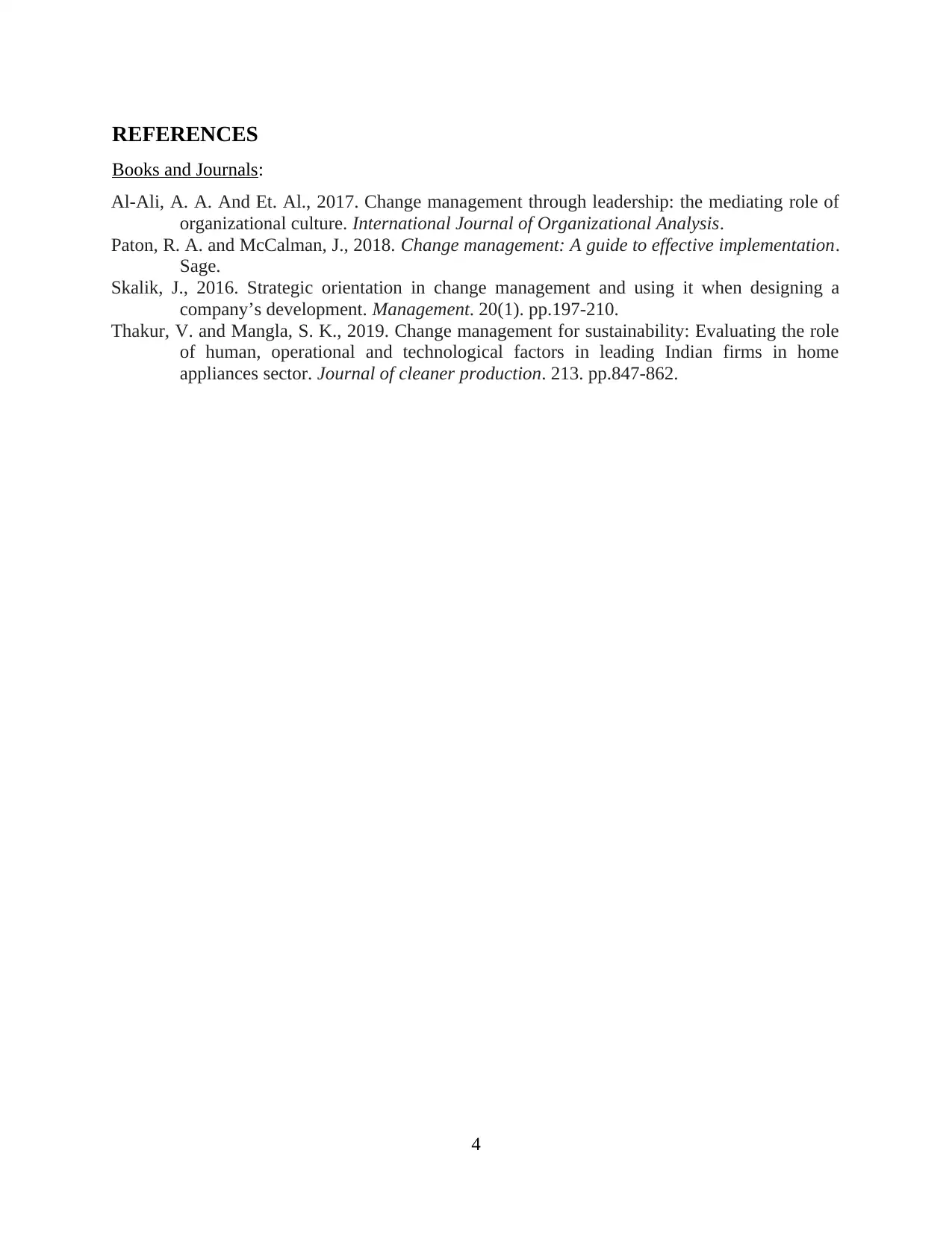
REFERENCES
Books and Journals:
Al-Ali, A. A. And Et. Al., 2017. Change management through leadership: the mediating role of
organizational culture. International Journal of Organizational Analysis.
Paton, R. A. and McCalman, J., 2018. Change management: A guide to effective implementation.
Sage.
Skalik, J., 2016. Strategic orientation in change management and using it when designing a
company’s development. Management. 20(1). pp.197-210.
Thakur, V. and Mangla, S. K., 2019. Change management for sustainability: Evaluating the role
of human, operational and technological factors in leading Indian firms in home
appliances sector. Journal of cleaner production. 213. pp.847-862.
4
Books and Journals:
Al-Ali, A. A. And Et. Al., 2017. Change management through leadership: the mediating role of
organizational culture. International Journal of Organizational Analysis.
Paton, R. A. and McCalman, J., 2018. Change management: A guide to effective implementation.
Sage.
Skalik, J., 2016. Strategic orientation in change management and using it when designing a
company’s development. Management. 20(1). pp.197-210.
Thakur, V. and Mangla, S. K., 2019. Change management for sustainability: Evaluating the role
of human, operational and technological factors in leading Indian firms in home
appliances sector. Journal of cleaner production. 213. pp.847-862.
4
1 out of 7
Related Documents
Your All-in-One AI-Powered Toolkit for Academic Success.
+13062052269
info@desklib.com
Available 24*7 on WhatsApp / Email
![[object Object]](/_next/static/media/star-bottom.7253800d.svg)
Unlock your academic potential
Copyright © 2020–2025 A2Z Services. All Rights Reserved. Developed and managed by ZUCOL.





